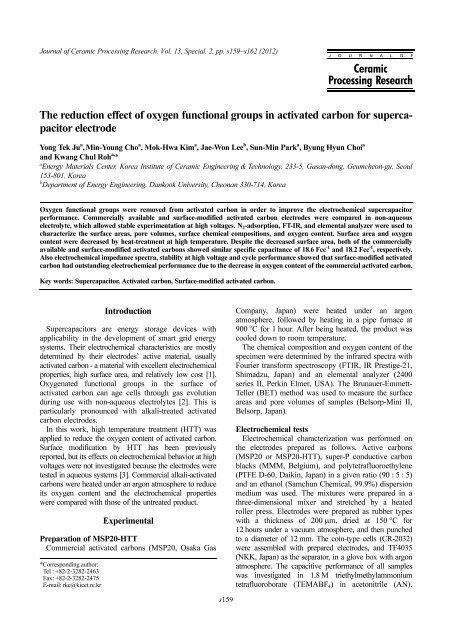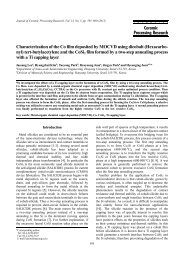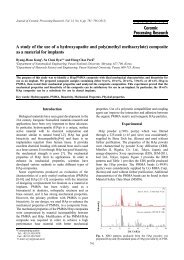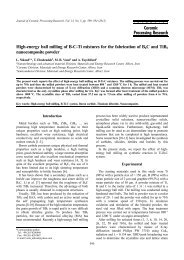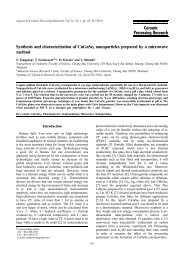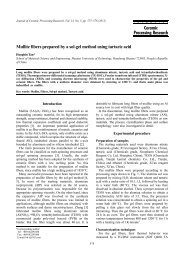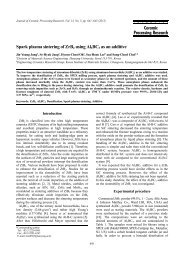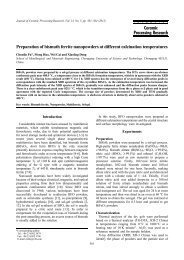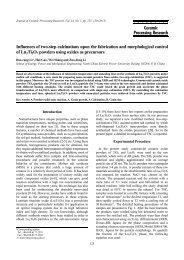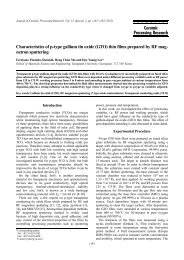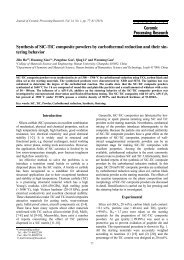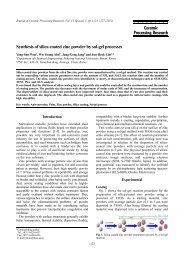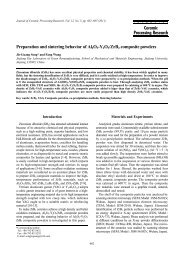The reduction effect of oxygen functional groups in activated carbon ...
The reduction effect of oxygen functional groups in activated carbon ...
The reduction effect of oxygen functional groups in activated carbon ...
Create successful ePaper yourself
Turn your PDF publications into a flip-book with our unique Google optimized e-Paper software.
Journal <strong>of</strong> Ceramic Process<strong>in</strong>g Research. Vol. 13, Special. 2, pp. s159~s162 (2012)<br />
J O U R N A L O F<br />
Ceramic<br />
Process<strong>in</strong>g Research<br />
<strong>The</strong> <strong>reduction</strong> <strong>effect</strong> <strong>of</strong> <strong>oxygen</strong> <strong>functional</strong> <strong>groups</strong> <strong>in</strong> <strong>activated</strong> <strong>carbon</strong> for supercapacitor<br />
electrode<br />
Yong Tek Ju a , M<strong>in</strong>-Young Cho a , Mok-Hwa Kim a , Jae-Won Lee b , Sun-M<strong>in</strong> Park a , Byung Hyun Choi a<br />
and Kwang Chul Roh a, *<br />
a Energy Materials Center, Korea Institute <strong>of</strong> Ceramic Eng<strong>in</strong>eer<strong>in</strong>g & Technology, 233-5, Gasan-dong, Geumcheon-gu, Seoul<br />
153-801, Korea<br />
b Department <strong>of</strong> Energy Eng<strong>in</strong>eer<strong>in</strong>g, Dankook University, Cheonan 330-714, Korea<br />
Oxygen <strong>functional</strong> <strong>groups</strong> were removed from <strong>activated</strong> <strong>carbon</strong> <strong>in</strong> order to improve the electrochemical supercapacitor<br />
performance. Commercially available and surface-modified <strong>activated</strong> <strong>carbon</strong> electrodes were compared <strong>in</strong> non-aqueous<br />
electrolyte, which allowed stable experimentation at high voltages. N 2 -adsorption, FT-IR, and elemental analyzer were used to<br />
characterize the surface areas, pore volumes, surface chemical compositions, and <strong>oxygen</strong> content. Surface area and <strong>oxygen</strong><br />
content were decreased by heat-treatment at high temperature. Despite the decreased surface area, both <strong>of</strong> the commercially<br />
available and surface-modified <strong>activated</strong> <strong>carbon</strong>s showed similar specific capacitance <strong>of</strong> 18.6 Fcc -1 and 18.2 Fcc -1 , respectively.<br />
Also electrochemical impedance spectra, stability at high voltage and cycle performance showed that surface-modified <strong>activated</strong><br />
<strong>carbon</strong> had outstand<strong>in</strong>g electrochemical performance due to the decrease <strong>in</strong> <strong>oxygen</strong> content <strong>of</strong> the commercial <strong>activated</strong> <strong>carbon</strong>.<br />
Key words: Supercapacitor, Activated <strong>carbon</strong>, Surface-modified <strong>activated</strong> <strong>carbon</strong>.<br />
Introduction<br />
Supercapacitors are energy storage devices with<br />
applicability <strong>in</strong> the development <strong>of</strong> smart grid energy<br />
systems. <strong>The</strong>ir electrochemical characteristics are mostly<br />
determ<strong>in</strong>ed by their electrodes’ active material, usually<br />
<strong>activated</strong> <strong>carbon</strong> - a material with excellent electrochemical<br />
properties, high surface area, and relatively low cost [1].<br />
Oxygenated <strong>functional</strong> <strong>groups</strong> <strong>in</strong> the surface <strong>of</strong><br />
<strong>activated</strong> <strong>carbon</strong> can age cells through gas evolution<br />
dur<strong>in</strong>g use with non-aqueous electrolytes [2]. This is<br />
particularly pronounced with alkali-treated <strong>activated</strong><br />
<strong>carbon</strong> electrodes.<br />
In this work, high temperature treatment (HTT) was<br />
applied to reduce the <strong>oxygen</strong> content <strong>of</strong> <strong>activated</strong> <strong>carbon</strong>.<br />
Surface modification by HTT has been previously<br />
reported, but its <strong>effect</strong>s on electrochemical behavior at high<br />
voltages were not <strong>in</strong>vestigated because the electrodes were<br />
tested <strong>in</strong> aqueous systems [3]. Commercial alkali-<strong>activated</strong><br />
<strong>carbon</strong>s were heated under an argon atmosphere to reduce<br />
its <strong>oxygen</strong> content and the electrochemical properties<br />
were compared with those <strong>of</strong> the untreated product.<br />
Experimental<br />
Preparation <strong>of</strong> MSP20-HTT<br />
Commercial <strong>activated</strong> <strong>carbon</strong>s (MSP20, Osaka Gas<br />
*Correspond<strong>in</strong>g author:<br />
Tel : +82-2-3282-2463<br />
Fax: +82-2-3282-2475<br />
E-mail: rkc@kicet.re.kr<br />
Company, Japan) were heated under an argon<br />
atmosphere, followed by heat<strong>in</strong>g <strong>in</strong> a pipe furnace at<br />
900 ο C for 1 hour. After be<strong>in</strong>g heated, the product was<br />
cooled down to room temperature.<br />
<strong>The</strong> chemical composition and <strong>oxygen</strong> content <strong>of</strong> the<br />
specimen were determ<strong>in</strong>ed by the <strong>in</strong>frared spectra with<br />
Fourier transform spectroscopy (FTIR, IR Prestige-21,<br />
Shimadzu, Japan) and an elemental analyzer (2400<br />
series II, Perk<strong>in</strong> Elmer, USA). <strong>The</strong> Brunauer-Emmett-<br />
Teller (BET) method was used to measure the surface<br />
areas and pore volumes <strong>of</strong> samples (Belsorp-M<strong>in</strong>i II,<br />
Belsorp, Japan).<br />
Electrochemical tests<br />
Electrochemical characterization was performed on<br />
the electrodes prepared as follows. Active <strong>carbon</strong>s<br />
(MSP20 or MSP20-HTT), super-P conductive <strong>carbon</strong><br />
blacks (MMM, Belgium), and polytetrafluoroethylene<br />
(PTFE D-60, Daik<strong>in</strong>, Japan) <strong>in</strong> a given ratio (90 : 5 : 5)<br />
and an ethanol (Samchun Chemical, 99.9%) dispersion<br />
medium was used. <strong>The</strong> mixtures were prepared <strong>in</strong> a<br />
three-dimensional mixer and stretched by a heated<br />
roller press. Electrodes were prepared as rubber types<br />
with a thickness <strong>of</strong> 200 µm, dried at 150 °C for<br />
12 hours under a vacuum atmosphere, and then punched<br />
to a diameter <strong>of</strong> 12 mm. <strong>The</strong> co<strong>in</strong>-type cells (CR-2032)<br />
were assembled with prepared electrodes, and TF4035<br />
(NKK, Japan) as the separator, <strong>in</strong> a glove box with argon<br />
atmosphere. <strong>The</strong> capacitive performance <strong>of</strong> all samples<br />
was <strong>in</strong>vestigated <strong>in</strong> 1.8 M triethylmethylammonium<br />
tetrafluoroborate (TEMABF 4 ) <strong>in</strong> acetonitrile (AN).<br />
s159
s160<br />
Yong Tek Ju, M<strong>in</strong>-Young Cho, Mok-Hwa Kim, Jae-Won Lee, Sun-M<strong>in</strong> Park, Byung Hyun Choi and Kwang Chul Roh<br />
Cyclic voltammetry (CV) and impedance spectroscopy<br />
were characterized us<strong>in</strong>g a potentiostat (EC-Lab,<br />
France). CV was carried out at a scan rate <strong>of</strong> 5 mVs -1<br />
between 0 V and 3.3 V. Impedance spectroscopy was<br />
carried out between 100 kHz and 100 mHz. Supercapacitor<br />
charge-discharge tests were conducted us<strong>in</strong>g a battery<br />
tester (Maccor series 4000, USA). In each cycle, the<br />
samples were charged at constant current (1 mAcm -2 ) to<br />
2.7 V. <strong>The</strong>n, 2.7 V constant voltage was ma<strong>in</strong>ta<strong>in</strong>ed<br />
while the charge current at 0.1 mAcm -2 . Cells were then<br />
discharged to 1.0 V at constant current (1 mAcm -2 ).<br />
Results and Discussion<br />
Structures <strong>of</strong> the <strong>carbon</strong> materials<br />
Pore structure parameters and elemental composition<br />
<strong>of</strong> the samples are listed <strong>in</strong> Table 1. After HTT, the<br />
<strong>carbon</strong> showed the reduced specific surface area and<br />
total pore volume, while the average diameter was<br />
unchanged. Liu et al. [3] reported that HTT can decrease<br />
total pore volume and surface area due to the expand<strong>in</strong>g<br />
and reorganization <strong>of</strong> the crystallite structures <strong>of</strong> the<br />
porous <strong>carbon</strong>.<br />
Table 1 compares the <strong>carbon</strong> and <strong>oxygen</strong> contents <strong>of</strong><br />
two samples with the elemental analyses. <strong>The</strong> <strong>oxygen</strong><br />
content decreased after HTT, result<strong>in</strong>g <strong>in</strong> the <strong>in</strong>crease<br />
<strong>of</strong> <strong>carbon</strong> content which is associated with higher<br />
electronic conductivity.<br />
Fig. 1(a) shows the FT-IR spectra <strong>of</strong> MSP20 and<br />
MSP20-HTT. <strong>The</strong> band around 3450 cm -1 corresponds<br />
to -OH stretch<strong>in</strong>g vibrations <strong>of</strong> hydroxyl group [5]. <strong>The</strong><br />
peak at 1629 cm -1 is characteristic <strong>of</strong> C = O stretch<strong>in</strong>g<br />
vibrations <strong>of</strong> lactonic and <strong>carbon</strong>yl <strong>groups</strong> [6, 7]. <strong>The</strong><br />
removal <strong>of</strong> <strong>oxygen</strong>-conta<strong>in</strong><strong>in</strong>g <strong>groups</strong> dur<strong>in</strong>g heat<br />
treatment greatly reduced the bands associated with those<br />
structures, result<strong>in</strong>g <strong>in</strong> a relative <strong>in</strong>crease <strong>of</strong> <strong>carbon</strong> content.<br />
Electrochemical characteristics<br />
Capacitance test<strong>in</strong>g was carried out at a current<br />
density <strong>of</strong> 1 mAcm -2 from 1.0 to 2.7 V to evaluate charge/<br />
discharge performances for MSP20 and MSP20-HTT.<br />
<strong>The</strong> specific capacitances <strong>of</strong> the cells were calculated<br />
by the follow<strong>in</strong>g equation from the discharge pr<strong>of</strong>ile:<br />
C=I• (T 2 –T 1 )/(V 1 -V 2 ) • (X), Where V 1 and V 2 are<br />
2.16 V and 1.08 V, respectively, I is 1.13 mA and X is<br />
the volume sum <strong>of</strong> each electrodes.<br />
Fig. 2 reveals the cycl<strong>in</strong>g performance <strong>of</strong> MSP20 and<br />
HTT-MSP20. <strong>The</strong> HTT-MSP20 exhibited a stable<br />
capacitance <strong>of</strong> about 18.0 Fcc -1 without severe fad<strong>in</strong>g<br />
at 1 mAcm 2 dur<strong>in</strong>g 1000 cycles. <strong>The</strong> <strong>in</strong>itial capacity<br />
was 18.2 Fcc -1 and the 1000th capacity was about<br />
18.0 Fcc -1 . <strong>The</strong> total capacitance fad<strong>in</strong>g was only 1.1%<br />
dur<strong>in</strong>g 1000 cycles. On the other hand, raw MSP20<br />
displayed a rather poorer cycl<strong>in</strong>g performance. <strong>The</strong> 1st<br />
capacitance was about 18.5 Fcc -1 and the 1000th<br />
capacity decreased to 17.6 Fcc -1 . Thus, the specific<br />
capacitance decay <strong>in</strong>creased to 5.0%, which was much<br />
larger than that <strong>of</strong> HTT-MSP20.<br />
Electrochemical impedance was measured to compare<br />
the samples’ electrical conductive properties. Nyquist<br />
plots <strong>of</strong> two-electrode systems employ<strong>in</strong>g the samples<br />
Fig. 1. FT-IR spectra <strong>of</strong> the (a) MSP20-HTT and (b) MSP20.<br />
Table 1. Porous structures and chemical compositions <strong>of</strong> <strong>activated</strong><br />
<strong>carbon</strong>s<br />
Porous structures<br />
S BET V T D A E D<br />
P R<br />
micro meso, macro<br />
MSP20 2379.6 1.03 1.7 0.55 82.93 17.07<br />
MSP20-HTT 2105.7 0.92 1.7 0.58 82.87 17.13<br />
Chemical<br />
compositions<br />
C H N S O<br />
(wt.%)<br />
MSP20 93.68 0.19 0.21 0.02 5.9<br />
MSP20-HTT 95.98 0.17 0.08 0.02 3.75<br />
S BET , specific surface area (m 2 g -1 ); V T , total pore volume (cm 3 g -1 );<br />
D A , average pore diameter (nm); E D , electrode density (g cm -3 );<br />
P R , pore ratio (%).<br />
Fig. 2. Cycl<strong>in</strong>g performances <strong>of</strong> the MSP20 and MSP20-HTT.
<strong>The</strong> <strong>reduction</strong> <strong>effect</strong> <strong>of</strong> <strong>oxygen</strong> <strong>functional</strong> <strong>groups</strong> <strong>in</strong> <strong>activated</strong> <strong>carbon</strong> for supercapacitor electrode<br />
s161<br />
Fig. 3. Nyquist plots <strong>of</strong> the MSP20 and MSP20-HTT (100 kHz –<br />
100 mHz).<br />
(Fig. 3) show high frequency semicircles associated with<br />
the resistance <strong>of</strong> the electrolyte solution, the <strong>in</strong>tr<strong>in</strong>sic<br />
resistance <strong>of</strong> the active material, and the contact<br />
resistance at the <strong>in</strong>terface active material/current collector.<br />
<strong>The</strong> similarity between the cell assemblies and the use <strong>of</strong><br />
the same electrolyte ensures that the differences between<br />
the high frequency semicircles resulted from the<br />
differences <strong>in</strong> the electric conductivity <strong>of</strong> the electrode<br />
materials [8]. <strong>The</strong> relative size <strong>of</strong> the semicircles shows<br />
that MSP20 has higher impedance than that <strong>of</strong> MSP20-<br />
HTT. <strong>The</strong> improved surface resistance <strong>of</strong> the HTT<br />
<strong>activated</strong> <strong>carbon</strong> is believed to be attributed to the<br />
<strong>reduction</strong> <strong>of</strong> <strong>oxygen</strong>-conta<strong>in</strong><strong>in</strong>g <strong>groups</strong>.<br />
<strong>The</strong> samples’ cyclic voltammograms were recorded<br />
vary<strong>in</strong>g upper limit voltage to 2.7, 2.9, 3.1, and 3.3 V<br />
(Fig. 4). <strong>The</strong> CV curves <strong>of</strong> MSP20 (Fig. 4(a)) do not<br />
overlap, and tails appear at higher voltage – <strong>in</strong>dicat<strong>in</strong>g<br />
different behavior from that <strong>of</strong> a typical supercapacitor.<br />
<strong>The</strong> observed current loss implies the occurrence <strong>of</strong><br />
side reactions, such as gas generation.<br />
An <strong>effect</strong>ive approach to achieve higher energy is to<br />
<strong>in</strong>crease the acceptable work<strong>in</strong>g voltage <strong>of</strong> conventional<br />
supercapacitors. Currently, the maximum voltage <strong>of</strong><br />
supercapacitors is limited to 2.5 - 2.7 V because <strong>of</strong><br />
significant decrease <strong>in</strong> capacitance, and cont<strong>in</strong>uous<br />
<strong>in</strong>crease <strong>in</strong> <strong>in</strong>ternal resistance at applied voltage over<br />
2.7 V. <strong>The</strong> undesired Faradaic process that leads to a<br />
capacitance fade over a certa<strong>in</strong> cell voltage is the most<br />
critical factor that determ<strong>in</strong>es the cycle life <strong>of</strong><br />
supercapacitors. <strong>The</strong> presence <strong>of</strong> <strong>oxygen</strong>ated <strong>groups</strong> on<br />
the surface <strong>of</strong> the <strong>activated</strong> <strong>carbon</strong> causes gaseous<br />
products <strong>of</strong> CO 2 and CO at electrodes [2].<br />
<strong>The</strong> cyclic voltammogram <strong>of</strong> MSP20-HTT (Fig. 4(b))<br />
shows greatly reduced tails and typical rectangular<br />
shapes <strong>of</strong> the material, which exhibits only electric double<br />
layer capacitance (i.e., no apparent pseudo-capacitance<br />
from Faradaic process) <strong>in</strong> the high voltage region. This<br />
Fig. 4. Cyclic voltammograms <strong>of</strong> the (a) MSP20 and (b) MSP20-<br />
HTT (scan rate: 5 mV/s).<br />
<strong>in</strong>dicates that the removal <strong>of</strong> <strong>oxygen</strong> <strong>functional</strong> <strong>groups</strong><br />
from the <strong>activated</strong> <strong>carbon</strong>’s surface improves its cycl<strong>in</strong>g<br />
stability at high voltages (2.7 ~ 3.3 V).<br />
Conclusions<br />
Activated <strong>carbon</strong> thermally treated at 900 °C lost<br />
<strong>oxygen</strong> <strong>functional</strong> <strong>groups</strong>, which led to improved<br />
electrical conductivity and lowered impedance. Despite<br />
the decreased surface area by HTT, <strong>activated</strong> <strong>carbon</strong><br />
showed similar capacitance and cycl<strong>in</strong>g performance to<br />
the commercial <strong>activated</strong> <strong>carbon</strong>. Also, a supercapacitor<br />
employ<strong>in</strong>g this heat-treated <strong>carbon</strong> as electrodes<br />
showed better high voltage performance than that <strong>of</strong><br />
the untreated <strong>activated</strong> <strong>carbon</strong>. This shows that the<br />
removal <strong>of</strong> <strong>oxygen</strong> <strong>functional</strong> <strong>groups</strong> from <strong>activated</strong><br />
<strong>carbon</strong>’s surface by HTT improved its high-voltage<br />
stability <strong>in</strong> a unit cell.<br />
Acknowledgements<br />
This research was supported by a grant from the<br />
Fundamental R & D Program for Technology <strong>of</strong> World<br />
Premier Materials funded by the M<strong>in</strong>istry <strong>of</strong> Knowledge
s162<br />
Yong Tek Ju, M<strong>in</strong>-Young Cho, Mok-Hwa Kim, Jae-Won Lee, Sun-M<strong>in</strong> Park, Byung Hyun Choi and Kwang Chul Roh<br />
Economy and by the Converg<strong>in</strong>g Research Center<br />
Program through the M<strong>in</strong>istry <strong>of</strong> Education, Science<br />
and Technology (2011K000973), Korea.<br />
References<br />
1. E. Frackowiak, F. Begu<strong>in</strong>, Carbon 39 (2001) 937-950.<br />
2. S. Ishimoto, Y. Asakawa, M. Sh<strong>in</strong>ya, and K. Naoi, J.<br />
Electrochem. Soc. 156 (2009) A563-A571.<br />
3. Y. Tian, Y. Song, Z. Tang, Q. Guo, L. Liu, J. Power<br />
Sources. 184 (2008) 675-681.<br />
4. S. Mitani, S.-I. Lee, K. Saito, S.-H. Yoon, Y. Korai, I.<br />
Mochida, Carbon 43 (2005) 2960-2967.<br />
5. C. Aguilar, R. Garcia, G. Soto-Garrido, R. Arriagada, Appl.<br />
Catal. B. Environ. 46 (2003) 229-237.<br />
6. C. Moreno-Castilla, M.V. Lopez-Ramon, F. Carrasco-<br />
Mar<strong>in</strong>, Carbon 38 (2000) 1995-2001.<br />
7. A. Abdel-Nasser, El-Hendawy, Carbon 41 (2003) 713-722.<br />
8. D. Hulicova, M. Kodama, H. Hatori, Chem. Mater. 18<br />
(2006) 2318-2326.


